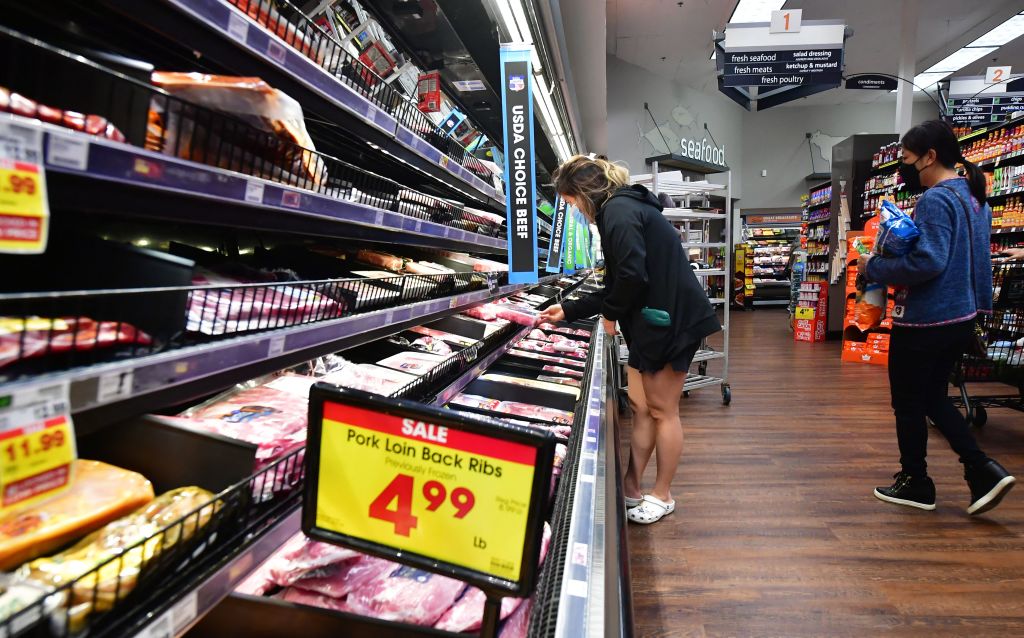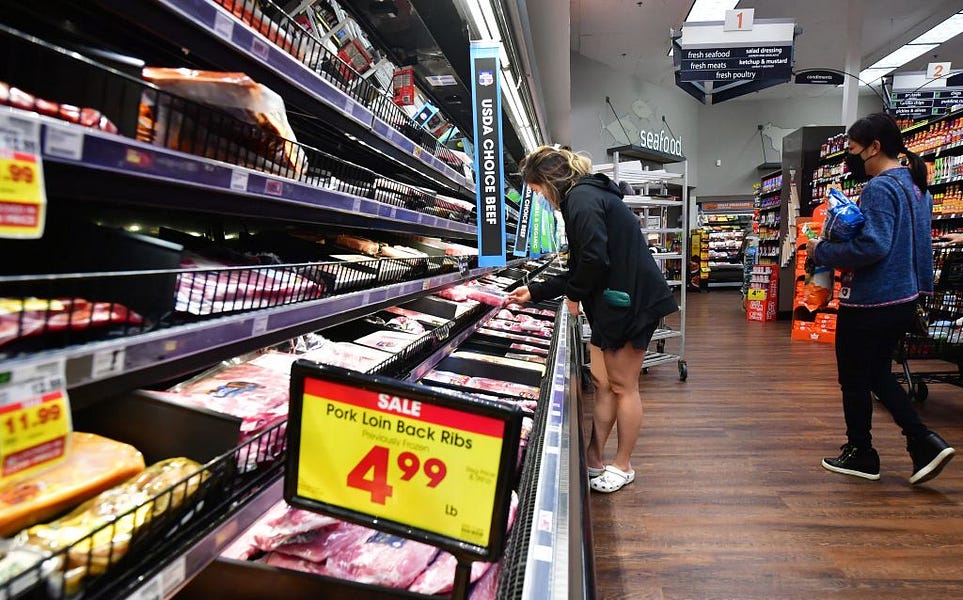Happy Thursday! Despite his best efforts, Rep. Madison Cawthorn still managed to find himself on the list of 398 U.S. lawmakers sanctioned by the Russian Foreign Ministry yesterday. Guy can’t catch a break!
Quick Hits: Today’s Top Stories
-
President Joe Biden formally announced yesterday his administration is authorizing an additional $800 million in military aid to Ukraine, including 11 Mi-17 helicopters, 18 howitzers, 300 Switchblade drones, 500 Javelin missiles, 200 M113 armored personnel carriers, equipment to protect against chemical and biological attacks, and more. The United States has now committed more than $2.5 billion in security assistance to Ukraine since Russia’s invasion in February. New satellite imagery from Maxar Technologies appears to show two Russian military resupply and maintenance bases have been established in southern Ukraine and Crimea, while Russian ground forces continue to advance toward the eastern Donbas region.
-
In response to Russia’s invasion of Ukraine, Finnish Prime Minister Sanna Marin announced Wednesday that Finland would launch a debate on the possibility of joining NATO, with a final decision expected “within weeks not within months.” Sweden—also officially unaligned militarily—is weighing the same decision. “There is a before and after 24 February,” Swedish Prime Minister Magdalena Andersson said yesterday. “The security landscape has completely changed.”
-
British Foreign Secretary Liz Truss announced yesterday the United Kingdom is sanctioning another 206 individuals connected to Russia’s war in Ukraine, including additional oligarchs and pro-Russian separatist leaders in Ukraine’s Donbas region. The U.K. will also ban imports of Russian steel and iron beginning this week.
-
The Centers for Disease Control announced Wednesday it would extend the federal mask mandate for airplanes and public transportation another 15 days—through May 3—so the agency can assess “the potential impact of the rise of cases” brought on by the Omicron BA.2 subvariant. It was slated to expire on April 18.
-
The Bureau of Labor Statistics reported Wednesday the producer price index—a measure of what suppliers and wholesalers are charging their customers—increased 1.4 percent in March on a seasonally adjusted basis, a step up from February’s 0.9 percent month-over-month increase. On an annual basis, PPI inflation hit 11.2 percent, the highest figure on record.
-
The Treasury Department reported this week the federal government ran a budget deficit of $193 billion in March 2022, a 71 percent decrease from March 2021. Outlays for the month fell 45 percent year-over-year as pandemic-related stimulus fell off—from $927 billion to $508 billion—and government receipts increased 18 percent.
-
New York City Mayor Eric Adams announced yesterday that Frank James—the 62-year-old man wanted in connection with Tuesday’s subway shooting—was arrested “without incident” on Wednesday. James has been charged with one count of violating 18 U.S.C. 1992(a)(7) by committing a terrorist attack against a mass transportation system. If convicted, he will face a potential life sentence.
Has Inflation Peaked?

The Bureau of Labor Statistics released its latest Consumer Price Index (CPI) report on Tuesday, and—just like the last 11 CPI reports—the topline numbers were bad. Worst-in-41-years bad. Muhammad Ali was still boxing the last time a CPI report was this bad. But once you pick your jaw up off the ground, say a prayer over your wallet, and get past the headlines pointing out annual inflation reached 8.5 percent in March, you’ll notice Tuesday’s report actually contains some signs that next month’s figure might be lower.
Part of this is simply structural. At a basic level, the year-over-year CPI inflation rate is calculated by comparing the value of the consumer price index—a weighted average approximating the cost of a set “basket of goods”—to what it was 12 months earlier. This month’s 8.5 percent figure, for example, was calculated by determining the difference between index values of 265.0 in March 2021 and 287.7 in March 2022.
For the past 11 months, the first number in all of those computations—the baseline—came from the pre-vaccine world of 2020 and early 2021, while the second number came from the learning-to-live-with-COVID era. Prices were particularly deflated in the former due to a stark dropoff in consumer demand, while prices were particularly inflated in the latter due to excess consumer savings and supply chain snafus. April 2021 was more or less the inflection point between the two periods, meaning that—beginning next month—the year-over-year index comparison will be more apples to apples.
But there are reasons for hope beyond those accounting details. Core CPI—which excludes the more volatile food and energy sectors—increased just 0.3 percent from February to March, the slowest pace since last September and much more in line with pre-pandemic averages. “A 0.3 percent month-over-month core number is kind of a ‘normal’ number,” Markets Policy Partners co-founder Brendan Walsh told The Dispatch. “It’s usually 0.1, 0.2, or 0.3.”
Driving this return to the upper bounds of “normal” was a slowdown in price increases for goods and commodities. The average cost of footwear, for example, increased 1.3 percent from January to February—but only 0.1 percent from February to March. The average cost of sporting goods increased 0.5 percent from January to February—but actually decreased 0.6 percent from February to March. And perhaps most significantly, used cars and trucks—one of the key contributors to inflation over the past year—were 3.8 percent cheaper in March than the month prior.
“Goods inflation is definitely slowing, and that’s what the huge inflation [this past year] was—we didn’t go out, and we bought a bunch of stuff,” Walsh said. That meant hundreds of millions of Americans—with record levels of savings thanks to pandemic stimulus—competing for a limited amount of products as companies struggled to ramp up manufacturing, resulting in higher prices. But supply and demand are starting to come back into balance, as supply chain issues are resolved, pandemic-era savings dwindle, and interest rate hikes slow capital investment. “The question now,” Walsh continued, “is how much is that goods inflation—or goods deflation, which is going to happen—counteracted by services inflation.”
That question was the subject of a Morning Dispatch about a month ago:
When costs first started setting off alarm bells last May—4.2 percent annual inflation, how quaint—the phenomenon really could mostly be explained away by a combination of post-pandemic supply chain snags and base effects (measuring against artificially low prices a year earlier). Used cars and trucks, appliances, and energy—industries affected by semiconductor shortages or long ramp-up periods—accounted for almost the entirety of the overall surge.
But that more modest, initial round of inflation was compounded over the past 10 months by additional pandemic stimulus, further supply chain hiccups, an incredibly tight labor market, and ultimately, shifting consumer and business expectations. The price increases have metastasized, setting off a chain reaction throughout the economy that will be difficult to contain.
Tuesday’s report did nothing to counteract that thesis. While the cost of commodities (save food and energy) held steady or decreased in March, core services inflation—referring to things like housing, healthcare, insurance, education, recreation, and public transportation—reached its highest level since 1991.
“I think the broad narrative for 2023 of, you’re going to see a shift from goods inflation to services inflation, that is playing out,” Jason Furman—Harvard University economist and former chair of President Barack Obama’s Council of Economic Advisers—told The Dispatch. “There’s an open question of [whether] goods prices come down faster than service prices go up. … And then there’s the wild card of all this volatile stuff being thrown in.”
“All this volatile stuff,” in this instance, refers primarily to the Russia-Ukraine conflict and its impact on food and gas prices. If you add those two categories back into the equation, March’s month-over-month inflation rate literally quadruples, from the aforementioned core 0.3 percent to 1.2 percent. Food costs increased 1 percent from February to March, while gas shot up a staggering 18.3 percent—though prices at the pump have been steadily declining for the past several weeks.
We’ve dealt primarily with core inflation the last few paragraphs for a reason: It’s the metric on which the Federal Reserve bases its 2 percent inflation target (they technically use core PCE inflation, which generally runs a little lower than core CPI), and it encompasses the sectors on which monetary policy can have more of an effect. “As a central bank, are you really going to overtighten to like, drive down the price of wheat?” Walsh asked. “It’s not just the Fed, it’s every central bank that’s in this quandary. You have this exogenous factor of a war that happens to be between one group that provides oil and natural gas to Europe and another one that provides wheat to basically a huge percentage of the world.”
But while it makes sense for the Fed to focus primarily on what it can control—and all indications are it’ll raise interest rates another half-percentage point at its meeting next month—American consumers don’t have the luxury of excluding trips to the grocery store or gas station from their budgets. In a CBS News/YouGov poll conducted last week, more than half the respondents reported cutting back on food due to higher prices, and two in three said they were driving less. Nearly 70 percent believed the Biden administration could be doing more to bring down the cost of gas.
The White House has made some moves in that direction in recent weeks—pledging to release up to 180 million barrels of oil from the United States’ Strategic Petroleum Reserve, issuing a waiver allowing gas with 15 percent ethanol content (E15) to be sold nationwide this summer—but they’re likely to have only a modest effect, just like most short-term inflation-fighting tools at Biden’s disposal.
“Look, the administration should be trying to do everything it can to help the supply side of the economy,” Furman said, adding that the “main stones remaining unturned” are trade related, like repealing the Jones Act and removing tariffs on China. “I don’t think it can add up to a lot, but there’s almost no downside, and there is upside, so they should do it.”
“They should also not do things that raise inflation,” he continued. “The student loan interest pause is going to raise inflation, and it may raise inflation more than several of the other steps they’ve taken would lower it. It’s sort of a ‘do no harm, and then do some good things.’ And they’re still doing a little bit of harm. But they’re also doing a bunch of good things.”
The administration is undoubtedly hoping that March truly is peak inflation—White House Chief of Staff Ron Klain went on a retweet spree this week pushing that message—but the internet is littered with incorrect inflation predictions from the past year, and the situation in Ukraine renders the situation even more mercurial.
“Headline inflation includes food and energy, and I think the scientific term for this is, ‘Who knows what the f— will happen,” Justin Wolfers—public policy and economics professor at the University of Michigan—told The Dispatch. Furman thinks it’s unlikely gas prices spike another 18 percent next month, but what if the situation in Ukraine gets so dire Europe decides to finally implement a ban on Russian energy imports? Goods inflation has slowed because supply chain snarls seem to have generally been worked out, but what if the Chinese Communist Party’s draconian COVID-19 lockdown in Shanghai spreads to other cities?
“A few weeks of the Port of Shanghai being shut down doesn’t matter that much because you have other ports, and it’s only a few weeks,” said Derek Scissors, a supply chain expert at the American Enterprise Institute. “But if you have a problem in Shenzhen in March, and a problem in Shanghai in April, what if the problem is the exporting city of Suzhou in May? It won’t get as many headlines as Shanghai, but it will matter a lot. That will add up.”
War in the Breadbasket
You don’t have to look beyond Ukraine’s flag to realize that when Russian President Vladimir Putin attacked Ukraine, he also attacked the world’s food supply. The blue and yellow bicolor represents clear skies over golden fields—appropriate for a country that supplies around 10 percent of the world’s wheat exports and nearly half of its sunflower seed oil market.
Russia also exports wheat, and its natural gas is crucial for making nitrogen-based fertilizer. Together the warring countries account for about 30 percent of the world’s wheat exports and 80 percent of sunflower exports. Global food prices, already up thanks to inflation and COVID-19 supply chain disruptions, climbed after the invasion and spiked to their highest-ever in March, according to the Food and Agriculture Organization, with wheat prices alone up 19.7 percent over the previous month.
The war has made it much harder to get crops where they need to go. The U.S. has carved out exceptions for food and fertilizer in its sanctions against Russia, but the market has other problems—ships that can’t afford insurance to enter Black Sea ports, for example, or traders who need new methods to pay Russia for its wheat now that it’s been kicked off the SWIFT banking system. And Russia itself suspended some grain exports to ex-Soviet countries.
Ukraine also temporarily curbed exports of several staple foods, and Russia has blocked grain ships leaving through the Black Sea, the primary shipping route for Ukraine’s wheat. About a third of last year’s wheat harvest is still in-country according to Joseph Glauber, former chief economist for the U.S. Department of Agriculture and a grain researcher at the International Food Policy Research Institute. The World Food Program estimates 13.5 million tons of wheat are stuck in Russia and Ukraine. “Frankly, we don’t know exactly where it all is,” Glauber told The Dispatch. “I don’t really know even how many silos might have been destroyed—or at least compromised—and how much grain was in those.”
Meanwhile, many farmers are fighting or fleeing, and diesel that would typically run their tractors is instead going to power military vehicles. We won’t know for sure how much the fighting has cut Ukrainian farmers’ ability to fertilize current crops and plant new ones until new crop growth shows up in satellite images over the next few months, Glauber said, but it’s a safe bet Ukraine will produce less than usual. If the war continues, it could also disrupt harvests in June and July.
All this disruption doesn’t necessarily mean we won’t have enough grain to go around. Russia and Ukraine may provide 30 percent of the world’s wheat exports, but they grew closer to 15 percent of its total 2020 crop. Many countries grow much of their own food, and they can dip into stockpiles and export more wheat than usual. India has already pumped its wheat exports to 7.85 million tons in the fiscal year to March, up from 2.1 million the year before.
Fertilizer itself is another chokepoint. Some farmers can use fertilizer more efficiently to keep costs down or trade high-nitrogen crops like corn for less fertilizer-intensive crops like soybeans. But with prices up, many farmers are already using less fertilizer, which will likely lower yields and drive prices higher.
And while consumers in the U.S. may be able to absorb higher grocery bills, poor countries that rely heavily on food imports will struggle to keep up with rising prices. Several smaller countries get almost all their wheat from Ukraine, and not all can afford the extra expense of shipping from the U.S. or other far-flung countries. Yemen, for example, imports about 97 percent of its cereals, and wheat is its top import—mostly from the U.S., Russia, and Ukraine. The country’s war has left 13 million people relying on food assistance. Donations have dropped as countries send humanitarian aid to Ukraine, forcing the United Nations to reduce food aid for 8 million people. Even the U.N.’s food program usually gets about half of its wheat from Ukraine.
With uncertainty about how long the war will last and how much it will damage Ukraine’s infrastructure—plus typical wildcards like droughts and blights—it’s difficult to say exactly how high food prices will go and for how long. The USDA predicted in March that they’ll increase up to 5 percent this year overall, while UN food program director David Beasley said it’ll be “a multi-year problem.” Glauber agreed, noting that if the war ends swiftly wheat prices could recover in 2023, but likely no sooner. “Hopefully this war won’t last very long and we’ll see that region come back and be back to more normal production levels,” he said. “But that’s going to take time.”
Worth Your Time
-
President Biden got out in front of his administration again earlier this week when he formally labeled Russian atrocities in Ukraine as genocide, well before the State Department is prepared to make that legal determination. For the Washington Post, Tyler Pager details that process—and how it’s affected by Biden’s ad-libbing. “Biden’s off-the-cuff comment marked the latest example of the tension between his often-emotional response to Putin’s brutal war and the international implications of a president’s words,” he writes. “The State Department [has a] painstaking process for reaching a genocide determination, which among other things requires clear documentation that the perpetrators intended to wipe out a group in whole or in part. Last month, for example, Secretary of State Antony Blinken declared that the slaughter of the Rohingya by the Burmese military was a genocide. Blinken described how the department had combed through detailed reports by an array of independent sources. ‘Given the gravity of this determination, it was also important that this administration conduct its own analysis of the facts and the law,’ Blinken said. He added, ‘Percentages, numbers, patterns, intent: these are critically important to reach the determination of genocide.’ Biden, however, did not appear to rely on any of those. ‘The president was calling it like he sees it, and that’s what he does,’ Psaki said.”
-
Earlier this month, David Broockman and Joshua Kalla published a study that found paying regular Fox News viewers to watch CNN for a few weeks dramatically shaped those viewers’ attitudes on current events, policy preferences, and political leaders. CNN’s Brian Stelter invited the study’s authors on his show last weekend to criticize Fox News’ “partisan coverage filtering,” but was flustered when they also took aim at his own network. “Fox and CNN cover different issues, and Fox News predominantly covers issues that make the GOP look good and make Democrats look bad,” Kalla said. “And on the flip side, CNN engages in this partisan coverage filtering as well as that we find. For example, during this time, the Abraham accords were signed and these were the agreements where Israel, the UAE, and Bahrain signed a major peace agreement. And we see that Fox News covered this really major accomplishment about 15 times more than CNN did. So we established both networks are really engaging in this partisan coverage filtering. It’s not about one side, it’s about the media writ large.”
-
Los Angeles Dodgers manager Dave Roberts committed a crime against baseball on Wednesday when he pulled ace pitcher Clayton Kershaw from the team’s game against the Minnesota Twins in the 8th inning—despite Kershaw having thrown a perfect game up to that point. “There have been only 23 perfect games in the 145-year history of Major League Baseball, and Kershaw was seven ninths of the way—77.77777 percent of the way—to recording the 24th,” Albert Burneko writes in a hilarious Defector blog post. “He is 34 years old; the odds against him ever again getting that close to perfection are like the odds that the same individual grain of sand will fly into your eye on two different continents. … Not allowing that performance to end on its own terms, either with the completion of what was shaping up to be one of the great pitching performances in the history of baseball or with a single Twin reaching base, is a horror. An abomination. It is like cannibalism! And no, my beliefs on this matter will not be swayed by the fact that Kershaw himself agreed with his manager’s decision to remove him from the game.”
Presented Without Comment
Presented Without Comment: September 2018 Edition
Presented Without Comment: April 2022 Edition
Toeing the Company Line
-
On the site today, Charlotte has an update on Afghanistan, including the Taliban’s friendliness with terrorist groups and America’s foreign adversaries, plus the lack of U.S. “over-the-horizon” military capabilities. And Giselle Donnelly unpacks why the Russian army has performed so badly in Ukraine.
Let Us Know
Are you optimistic that we may be turning the proverbial corner on inflation? Or are you in the I’ll-believe-it-when-I-see-it camp?







Please note that we at The Dispatch hold ourselves, our work, and our commenters to a higher standard than other places on the internet. We welcome comments that foster genuine debate or discussion—including comments critical of us or our work—but responses that include ad hominem attacks on fellow Dispatch members or are intended to stoke fear and anger may be moderated.
With your membership, you only have the ability to comment on The Morning Dispatch articles. Consider upgrading to join the conversation everywhere.